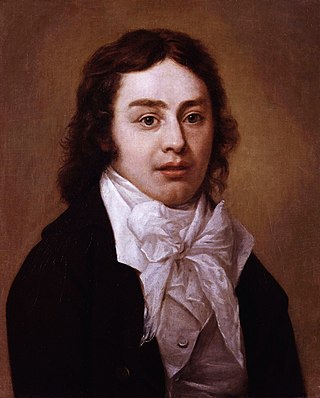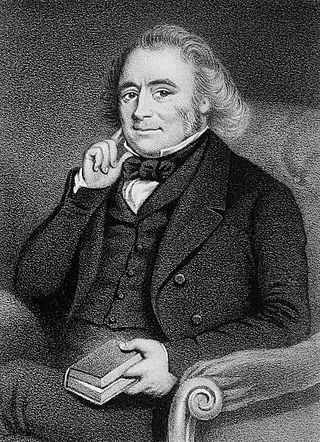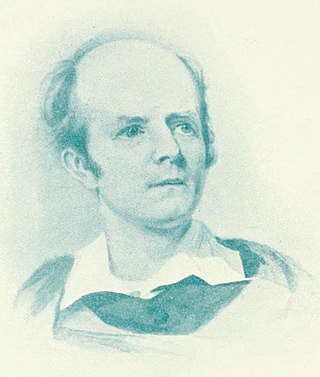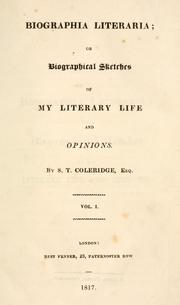Related Research Articles

Samuel Taylor Coleridge was an English poet, literary critic, philosopher, and theologian who, with his friend William Wordsworth, was a founder of the Romantic Movement in England and a member of the Lake Poets. He also shared volumes and collaborated with Charles Lamb, Robert Southey, and Charles Lloyd.

Suspension of disbelief is the avoidance—often described as willing—of critical thinking and logic in understanding something that is unreal or impossible in reality, such as something in a work of speculative fiction, in order to believe it for the sake of enjoying its narrative. Historically, the concept originates in the Greco-Roman principles of theatre, wherein the audience ignores the unreality of fiction to experience catharsis from the actions and experiences of characters. The phrase was coined and elaborated upon by the English poet and philosopher Samuel Taylor Coleridge in his 1817 work Biographia Literaria: "that willing suspension of disbelief for the moment, which constitutes poetic faith".

The Rime of the Ancient Mariner is the longest major poem by the English poet Samuel Taylor Coleridge, written in 1797–98 and published in 1798 in the first edition of Lyrical Ballads. Some modern editions use a revised version printed in 1817 that featured a gloss. Along with other poems in Lyrical Ballads, it is often considered a signal shift to modern poetry and the beginning of British Romantic literature.
Mimesis is a term used in literary criticism and philosophy that carries a wide range of meanings, including imitatio, imitation, nonsensuous similarity, receptivity, representation, mimicry, the act of expression, the act of resembling, and the presentation of the self.

Hartley Coleridge, possibly David Hartley Coleridge, was an English poet, biographer, essayist, and teacher. He was the eldest son of the poet Samuel Taylor Coleridge. His sister Sara Coleridge was a poet and translator, and his brother Derwent Coleridge was a scholar and author. Hartley was named after the philosopher David Hartley.
The Lake Poets were a group of English poets who all lived in the Lake District of England, United Kingdom, in the first half of the nineteenth century. As a group, they followed no single "school" of thought or literary practice then known. They were named, only to be uniformly disparaged, by the Edinburgh Review. They are considered part of the Romantic Movement.

Joseph Cottle (1770–1853) was an English publisher and author.

"Ode: Intimations of Immortality from Recollections of Early Childhood" is a poem by William Wordsworth, completed in 1804 and published in Poems, in Two Volumes (1807). The poem was completed in two parts, with the first four stanzas written among a series of poems composed in 1802 about childhood. The first part of the poem was completed on 27 March 1802 and a copy was provided to Wordsworth's friend and fellow poet, Samuel Taylor Coleridge, who responded with his own poem, "Dejection: An Ode", in April. The fourth stanza of the ode ends with a question, and Wordsworth was finally able to answer it with seven additional stanzas completed in early 1804. It was first printed as "Ode" in 1807, and it was not until 1815 that it was edited and reworked to the version that is currently known, "Ode: Intimations of Immortality".
Lines on an Autumnal Evening was composed by Samuel Taylor Coleridge in 1793. The poem, rewritten throughout Coleridge's life, discusses nature and love. As Coleridge developed and aged, the object of the poem changed to be various women that Coleridge had feelings toward.

"To Burke" is a sonnet by Samuel Taylor Coleridge first published in the 9 December 1794 Morning Chronicle. Unlike most of the Sonnets on Eminent Characters, "To Burke" describes a person whom Coleridge disagreed with; he felt Edmund Burke abused the idea of freedom within various speeches and turned his back on liberty.
"To Bowles" was written by Samuel Taylor Coleridge and published in the 26 December 1794 Morning Chronicle as part of the Sonnets on Eminent Characters series. William Lisle Bowles's poetry was introduced to Coleridge in 1789 and Bowles had an immediate impact on Coleridge's views of poetry. The sonnet celebrates Bowles's status as a poet. It also discusses Bowles's political beliefs, which helped shape Coleridge's ideas on government and politics.

The Feast of the Poets is a poem by Leigh Hunt that was originally published in 1811 in the Reflector. It was published in an expanded form in 1814, and revised and expanded throughout his life. The work describes Hunt's contemporary poets, and either praises or mocks them by allowing only the best to dine with Apollo. The work also provided commentary on William Wordsworth and Romantic poetry. Critics praised or attacked the work on the basis of their sympathies towards Hunt's political views.

Esemplastic is a qualitative adjective which the English romantic poet Samuel Taylor Coleridge claimed to have invented. Despite its etymology from the Ancient Greek word πλάσσω for "to shape", the term was modeled on Schelling's philosophical term Ineinsbildung – the interweaving of opposites – and implies the process of an object being moulded into unity. The first recorded use of the word is in 1817 by Coleridge in his work, Biographia Literaria, in describing the esemplastic – the unifying – power of the imagination.

Coleridge's notebooks, of which seventy-two have survived, contain a huge assortment of memoranda set down by the poet Samuel Taylor Coleridge from 1794 until shortly before his death in 1834. Coleridge's biographer Richard Holmes summarised the range of material covered as "travels, reading, dreams, nature studies, self-confession and self-analysis, philosophical theories, friendships, sexual fantasies, lecture notes, observations of his children, literary schemes, brewing recipes, opium addiction, horrors, puns, prayers." Some of this vast storehouse of material found its way into Coleridge's published works, and it is also believed to have directly influenced Wordsworth's poems. The notebooks have been described as "unique in the annals of Romantic autobiography", and as "perhaps the unacknowledged prose masterpiece of the age".
Romantic epistemology emerged from the Romantic challenge to both the static, materialist views of the Enlightenment (Hobbes) and the contrary idealist stream (Hume) when it came to studying life. Romanticism needed to develop a new theory of knowledge that went beyond the method of inertial science, derived from the study of inert nature, to encompass vital nature. Samuel Taylor Coleridge was at the core of the development of the new approach, both in terms of art and the 'science of knowledge' itself (epistemology). Coleridge's ideas regarding the philosophy of science involved Romantic science in general, but Romantic medicine in particular, as it was essentially a philosophy of the science(s) of life.

System of Transcendental Idealism is a book by Friedrich Wilhelm Joseph Schelling published in 1800. It has been called Schelling's most important early work, and is best known in the English-speaking world for its influence on the poet and philosopher, Samuel Taylor Coleridge. In this work, Schelling attempted to discover the ground of knowledge, within a Kantian framework. An English translation was first published in 1978.

The White Doe of Rylstone; or, The Fate of the Nortons is a long narrative poem by William Wordsworth, written initially in 1807–08, but not finally revised and published until 1815. It is set during the Rising of the North in 1569 and combines historical and legendary subject-matter. It has attracted praise from some critics, but has never been one of Wordsworth's more popular poems.

Romanticism was an artistic, literary, and intellectual movement that originated in Europe toward the end of the 18th century. Scholars regard the publishing of William Wordsworth's and Samuel Coleridge's Lyrical Ballads in 1798 as probably the beginning of the movement in England, and the crowning of Queen Victoria in 1837 as its end. Romanticism arrived in other parts of the English-speaking world later; in the United States, it arrived around 1820.
The Opus Maximum was a set of philosophical manuscripts dictated by Samuel Taylor Coleridge to his friend and colleague, Dr Joseph Henry Green, between 1819 and 1823. It was not published in Coleridge's lifetime, finally emerging in the 2002 version edited by Thomas McFarland with the assistance of Nicholas Halmi.
Love is a poem by Samuel Taylor Coleridge, first published in 1799 as Introduction to the Tale of the Dark Ladie.
References
- ↑ Nicholas Reid, Coleridge, Form and Symbol, Aldershot: Ashgate, 2006, p.123
- ↑ Kathleen Wheeler, Sources, Processes and Methods in Coleridge's Biographia Literaria, Cambridge: CUP, 1980,
- ↑ See James Engell's introduction to Samuel Taylor Coleridge, Biographia Literaria, ed James Engell and W. Jackson Bate, Princeton: PUP/Bollingen, 1983, Vol I, p.lxv (on reception) and p.cxiv (on plagiarism). The early accusers were De Quincey and Ferrier, while the chief prosecutors in the twentieth century were Norman Fruman (The Damaged Archangel, Braziller, 1971) and Rene Wellek (Immanuel Kant in England, Princeton: PUP, 1931)
- ↑ See James Engell's introduction to Samuel Taylor Coleridge, Biographia Literaria, ed James Engell and W. Jackson Bate, Princeton: PUP/Bollingen, 1983, Vol I, p.xli.
- ↑ Stephen Prickett, Coleridge and Wordsworth: The Poetry of Growth, Cambridge: CUP, 1970, Chapter 2.
- ↑ Samuel Taylor Coleridge, Biographia Literaria, Princeton: PUP/Bollingen, 1983, chapter 13, Vol.I, p.304
- ↑ Nicholas Reid, 'The Satanic Principle in the later Coleridge's theory of imagination', Studies in Romanticism, 37.2 (Summer 1998), pp.259-277; reprinted in Coleridge, Form and Symbol, Aldershot: Ashgate Publishing, 2006, chapter 7.
- ↑ Samuel Taylor Coleridge, Biographia Literaria, ed. James Engell and W. Jackson Bate, Princeton: PUP/Bollingen, 1983, Vol I, Chapter 13, p.304; and Table Talk, ed. Carl Woodring, Princeton: PUP, 1990, Vol.I, p.492 (28 June 1834.
- ↑ See James Engell's introduction to Samuel Taylor Coleridge, Biographia Literaria, ed James Engell and W. Jackson Bate, Princeton: PUP/Bollingen, 1983, Vol I, p.civ.
- ↑ Samuel Taylor Coleridge, Biographia Literaria, ed James Engell and W. Jackson Bate, Princeton: PUP/Bollingen, 1983, Vol I, Chapter 13, pp.296-297.
- ↑ Joan Steigerwald, 'Nature in Schelling's Philosophy', Studies in Romanticism 41.4, Winter 2002, p.527.
- ↑ Nicholas Reid, Coleridge, Form and Symbol, Aldershot: Ashgate Publishing, 2006, p.123.
- ↑ Samuel Taylor Coleridge, Biographia Literaria, ed James Engell and W. Jackson Bate, Princeton: PUP/Bollingen, 1983, Vol I, p.lvii and p.300.
- ↑ Nicholas Reid, Coleridge, Form and Symbol, Aldershot: Ashgate Publishing, 2006, p.106.
- ↑ Mary Anne Perkins, Coleridge's Philosophy, Oxford: OUP, 1994, p.10.
- ↑ Nicholas Reid, "Coleridge and Schelling: The Missing Transcendental Deduction," Studies in Romanticism, 33.3 (Fall 1994), 451-479, reprinted in Coleridge, Form and Symbol, Aldershot: Ashgate Publishing, 2006, pp.116-136.
- This article incorporates text from a publication now in the public domain : James H. Hanford (1920). . In Rines, George Edwin (ed.). Encyclopedia Americana .
